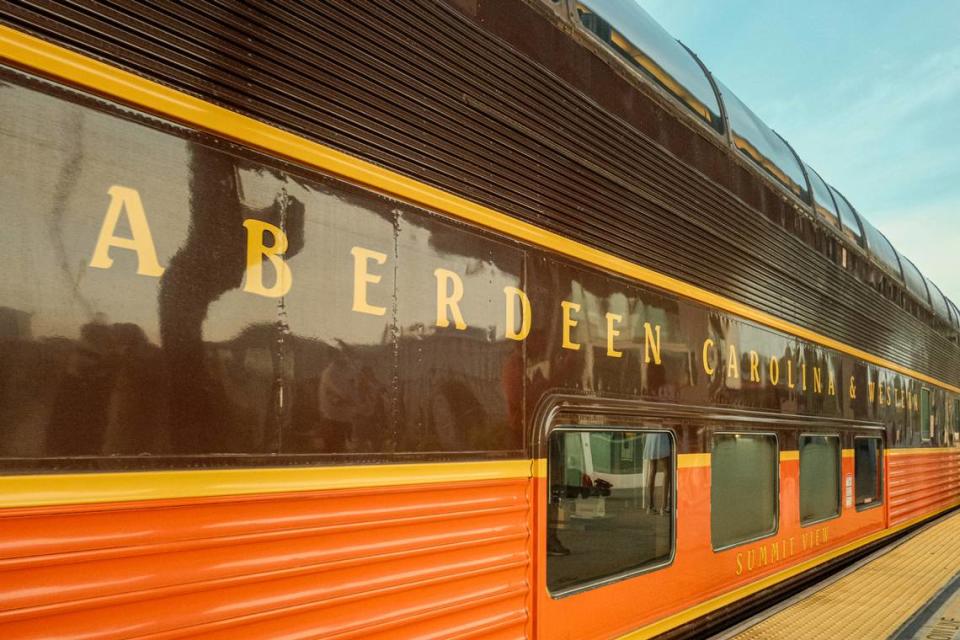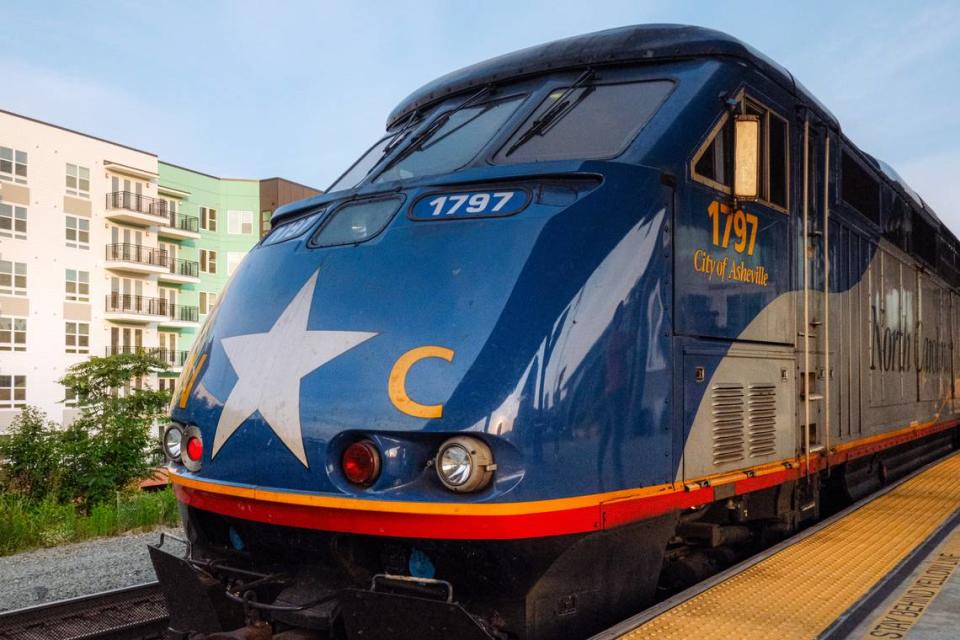All aboard the US Open Express, a picturesque ride into Pinehurst’s past
The U.S. Open Express pulled into Raleigh’s Union Station as planned a little before 7 Thursday morning, its engine churning and exhaust bellowing, the bells of a railroad crossing blaring not too far in distance.
It was a throwback scene for a throwback experience, people gathered on the platform and lined up to take a leisurely two-plus-hour ride to Pinehurst.
Soon enough, conductors guided passengers on board. Seats began to fill. There were older couples and foursomes of young golf bros, young kids and retirees with fading old U.S. Open hats, all on the way to see their first Open or maybe their third or fourth or more, and getting there in the best possible way: by sitting and watching the countryside pass by in the blur, the pines growing taller.
This is the fourth time the U.S. Open is at Pinehurst No. 2. Go back and watch highlights of the first two times it was there, in 1999 and 2005, and the place looks much different than it does today. It’s greener and more lush, with thick rough bordering the fairways. Before the Open returned in 2014, Pinehurst brought in a team to restore the course to its natural state.
A lot of that rough disappeared. No. 2 went back to its roots, with vast and sandy waste areas filled with wiregrass and thick brush that consumes errant shots and often leaves those who hit them there just hoping to escape, a bogey sometimes as fulfilling as a birdie. It’s golf the way it was always meant to be at Pinehurst, with those waste areas offering an additional defense of greens designed to infuriate and punish, or at the least require incredible touch.
Sights, sounds, charm
If the course itself is a modernized version of what it used to be, and what it was always meant to be, then it’s the same kind of thought behind arriving there by train. Sure, driving Thursday morning might’ve been a little faster, even with parking a ways away and shuttling in. But then we would’ve missed the sights and the sounds and the charm.
And the line for the dining car a little after 7 a.m.
The train was just about to pull into Cary, the first of its three stops (along with Southern Pines and the final destination of Pinehurst), and the dining car line was already almost the length of a train car. Some of the most popular requests: Moscow Mules (in a can, for $9) and Bloody Marys, which weren’t actually on the menu.
“I’m doin’ beer,” a late-20- or early-30-something golf enthusiast said near the back of the line, to no one in particular, and he had plenty of company; aspiring imbibers paying $8 for the cheapest domestic can and the more shrewd emptying airplane bottles into small cups of orange juice.
There is always something romantic and idyllic about train travel, but all of that is magnified when it’s train travel to the U.S. Open — and to Pinehurst, in particular. In the late 1800s and through the first decades of the 20th century, rail travel helped turn an upstart golf resort in North Carolina’s Sandhills into a national destination. A long time ago, Pinehurst was in the middle of land nobody really wanted or ever had reason to visit. Trains helped change all that.
“When this started in 1895, it was the only way to get here,” said Robert Menzies, the owner and chairman of the Aberdeen Carolina & Western Railway Company. Along with Amtrak and the North Carolina Department of Transportation, the Aberdeen Carolina & Western helped make the Open Express a possibility, and then a reality.

Trains used to bring people to Pinehurst from all over the East Coast. There were once advertisements in Grand Central Station in New York City enticing golfers and others to come South, to a part of North Carolina that was then in its infancy, and those who made the trip would board the train in the afternoon and arrive in the Sandhills by the next morning.
A different world
Anyone who slept through the night would awake to a different world upon arrival — a world of endless tall pines and a kind of sandy, silty soil that’s not good for farming but that nonetheless proved attractive enough to form the foundation of one of America’s greatest golf courses. The long overnight ride was worth it for many a passenger.
The same could be said on Thursday morning, the first of eight sold-out rides — one there and one back on each of the Open’s four tournament days. Raleigh’s downtown soon faded into the distance while the whistle howled, and then we were moving south of Cary and into a tunnel of trees. If a U.S. Open in Pinehurst is a weeklong love letter to the beauty of North Carolina, then riding the train there is a worthy accompaniment.

The ride passed through downtown Sanford, with small shops and old warehouses near the crossing. Then more forests, the countryside full of longleaf pines. An old barn here and there. An old farmhouse. Country crossings marked only by a wooden “X” on top of a crooked pole. Anyone who hadn’t been on a train before might’ve been nervous about how it all would go.
“I guess it’s like being on the Titanic,” said Greg Nardo, who’d walked from his downtown Raleigh apartment to the train station, where he met four friends with a guys’ trip for the first round of the Open. “It’s like the maiden voyage, so we’ll see how it goes.”
Nothing to fear. No icebergs. Just trees and small towns and a ride through a part of forgotten North Carolina, but a part no less pretty than a lot of other parts in the state.
Somewhere just north of Cameron, with its quaint but tiny strip of a Main Street visible from the windows, word began to spread that Tiger Woods had birdied his first hole — that Tiger Woods was leading this 124th playing of the U.S. Open. And who cared if it was way early or if he had 71 holes to go (maybe, if he makes the cut). Woods had birded his first hole and the sun was coming through the trees and everyone here was headed to the course, the anticipation building.
At last the conductor’s voice came over the train’s speakers:
“Pinehurst! PIIIIIINEHURST will be our next and final destination,” he said.

It’d been a long time since a commercial passenger train had been on these rails, with this many people. Decades, perhaps. The first three U.S. Opens here — four, counting the Women’s Open in 2014 — came and went without the kind of rail service that first allowed Pinehurst national prominence. And long ago, by the 1950s or so, visitors made their way here by different means.
The world has only grown faster, the pace only more hectic. Everyone seems to be in a rush, always. Sometimes, though, the perfect way to spend a Thursday morning is on a train headed down to the U.S. Open. The countryside blurs past but somehow it feels like time moves slower. We hit Aberdeen not long after Cameron, switched onto a local track and the train slowed to a crawl, or maybe a fast run.
That was OK. For once nobody was in a hurry. Soon enough the course came into view, the brilliant green of the fairways bursting through the gaps in longleafs. Somewhere Tiger was out there, his very early lead long gone, and No. 2 was already making mortals out of many of the very best golfers in the world. Finally the train slowed to a stop.
The Open Express was about 20 minutes late, technically, but in another way it arrived right on time.
Uniquely NC is a News & Observer subscriber collection of moments, landmarks and personalities that define the uniqueness (and pride) of why we live in the Triangle and North Carolina.

 Yahoo Sports
Yahoo Sports 
